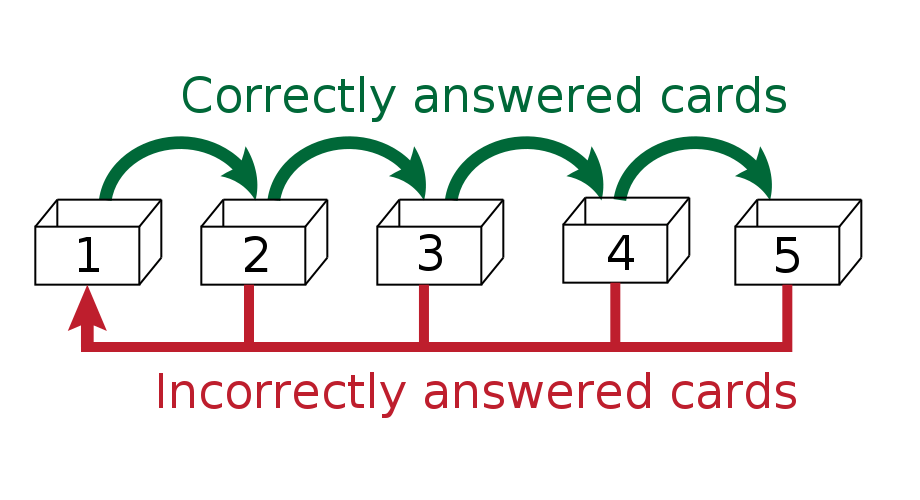Podcast: Download
Subscribe: Apple Podcasts | RSS

It works.
But there’s a big “if” when using any spaced repetition system.
You have to use this form of rehearsal correctly.
The good news is that it’s not hard to make sure you’re bringing the most effective approach.
And the correct way of applying this spaced learning tactic is exactly what you’re going to learn on this page.
The best part?
There are some unique ways you can apply this scientifically-valid learning approach to many things you might want to learn.
Once you get it right, this memory technique will help you remember large volumes of information quickly. It will be your go-to learning tool for the rest of your life.
Ready?
Let’s dive in!
What Is Spaced Repetition?
Spaced repetition simply means repeatedly exposing yourself to information and using active recall on an optimized schedule. In other words, “space” refers to the arrangement of time. As a memory hack, it’s a powerful alternative to cramming.
Scholars aren’t entirely sure, but the ancient poet Horace may have been the first to identify this principle when he reportedly said, “Repetition is the mother of learning.”
Here’s the problem:
People don’t like to repeat things over and over again. That’s called rote learning and it’s known to stunt critical thinking skills.
Our dislike for meaningless repetition is probably why ancient memory techniques evolved. By using mnemonics in combination with spaced learning, we’ve been able to optimize repetition in learning. This means that as a species, we’ve been able to reduce repetition.
As old as spaced repetition is (I’ve found evidence of it in Aristotle), it wasn’t until Hermann Ebbinghaus released his study Memory: A Contribution to Experimental Psychology that we had a full scientific examination of just how many times you need to repeat information before it sticks. To figure out how memory works, Ebbinghaus memorized over 2000 nonsense syllables and worked out how much time it took him to forget them. There’s an online program you can use to try and memorize them yourself.
As Ebbinghaus put it, retention has a number, and this number can be increased by defeating what is now called the forgetting curve. Ebbinghaus first described this effect in 1885, and you can still read articles from scientists working to optimize how we repeat information.

Learning to use spaced repetition to defeat the Forgetting Curve started in earnest with the research of Hermann Ebbinghaus.
As Ebbinghaus tracked his rate of forgetting, certain principles emerged that enabled him to remember information for longer periods of time while at the same time reducing the required amount of exposure needed to retain the information. Spaced repetition thus entered its infancy.
How Spaced Repetition Learning Turns Your Brain Into a Powerful Memory Device
As Ebbinghaus and many other scientists have shown, looking at information you need to learn coupled with retrieval practice works to form neurochemical connections in the brain.
Scientists think that the majority of the bonds in your brain form while you are sleeping, a process known as memory consolidation. This is why you sometimes get the advice to study before you go to sleep.
Many people have worked out different repetition and retrieval patterns to try and optimize the system. Some people find that randomness works best, while other studies show that regular intervals provide much faster results.
Spacing the amount of time between exposure and recall is the core of the Pimsleur Method and learning software like Anki. It’s also at the core of the Leitner System and the similar Zettelkasten technique.

The Leitner spaced repetition system helps you manage your exposure by placing accurate and inaccurate flashcards in boxes.
Ultimately, scientists and memory experts don’t know exactly why spacing out our learning periods work. We just know that it does.
Even better, we know how to improve learning revisions sessions, which we’ll discuss soon.
How to Choose the Right Spaced Repetition Schedule for You
The first step is to choose how you’re going to engage in spaced repetition learning. You can do it by:
- Manually setting the reviews times in your calendar
- Flashcards
- Using a spaced repetition software
- Using a Leitner or Zettelkasten system
- Using a Memory Palace system
No matter what you choose, here are some suggested schedules.
Schedule #1: Irregular Spacing
When learning and coming back to the material, you can space out your exposure and retrieval in irregular doses. In other words, you can randomly choose to review material on an irregular pattern like:
- After one day
- After three days
- After two days
- After seven days
- After five days
- After one day, etc.
Schedule #2: Regular Spacing
As cited above, some studies find that regular rehearsal patterns work better when you want to memorize something fast.
Dominic O’Brien, creator of the Dominic System for memorizing numbers, teaches what he calls the Rule of Five:
- Once a day for five days
- Once a week for five weeks
- Once a month for five months
There’s nothing magic about the number five, however. You could easily change it to two or seven. The point is that the intervals are regular instead of irregular.
I personally modify this approach for many of own learning projects by repeating new information 5 times a day for the first 5 days. I find this incredibly effective, especially for language learning or tough things like Morse Code.
Schedule #3: Blended Spacing
There are many kinds of information where you don’t have to choose irregular or regular spacing. You can combine the two for maximum effect.
Often, the blending will happen naturally. For example, if you’re using graded readers in language learning, you will naturally receive additional exposure.
A similar effect will happen when reading any book with terms you’re memorizing. You can revisit them on a regular pattern and also get random exposure as you study the topic over time. This kind of blended exposure is ideal whenever you can get it.
In other words, the best repetition schedule is really not one or the other, but both.
The Most Effective Way to Use Spaced Repetition
Once you’ve settled on how you’re going to use the spaced repetition method and decided on the scheduling, it’s time to optimize the entire process.
But here’s where many people make a huge mistake:
They simply expose themselves to the information they’re trying to learn. This activity is closer to rote learning, and although it can work, isn’t fun or all that interesting.
Here’s what to do instead.
Step #1: Elaborate While Learning
Never simply read or review the information. Whether it’s terminology or a diagram, always interact with it by using mnemonic imagery.
For example, if you’re learning a new word like “brachial plexus,” imagine stomping on brakes made out of plexiglass.
This process is called elaborative rehearsal and it makes information very sticky, very fast. To get better at it, give these elaboration exercises and visualization exercises try.
If you’re skeptical, Dr. David Reser and Tyson Yunkaporta have published research demonstrating that medical students who did this retained far more information than a control group.
In that study, participants used a journey method, which is like the Memory Palace technique. It’s well worth making mnemonic devices like that part of the elaboration process for best results.
And listen, if you can’t quite picture what I mean, here are some powerful Memory Palace examples for you.
Step #2: Let Your Chosen Amount of Time Pass
This part is simple. You really don’t have to do anything. You can go have fun with your friends, play games, music or check out a movie.
Or, as we discussed above, you can get some sleep to help your memories form faster.
Step #3: Recall Your Elaborations First
Here’s two errors a lot of people make:
- They look at the information before trying to recall it during the next rehearsal, or…
- They try to recall the information without using their elaborations as part of the process
You can form memories faster by avoiding these two errors.
When it comes time to review your learning material, don’t look at your flash cards or spaced repetition software first. Instead, write out what you remember from memory first.
This challenge, which is part of active recall, will help you learn the material faster. It’s also a means of boosting your concentration as you study.
Even if you make a mistake, you will still benefit. In fact, making mistakes helps you learn faster because it causes you to think about what went wrong and how to fix the issue.
When writing out your answers, make sure it’s on paper. Research has demonstrated you will learn faster by using a notebook than a tablet or computer.
Step #4: Add Other Repetition Opportunities
I learned very fast in university because some of the places I used to study involved groups of my peers. We would talk about what we were learning and listen to each other. This simple act rapidly improved memory formation.
You can also seek out additional books, podcasts and video tutorials related to your topic.
Finally, write summaries as much as you can. You don’t have to build an elaborate blog to do this. You can leave comments on videos you’ve learned from or share in social media posts.
These are highly overlooked forms of spaced repetition that are very powerful. Please make use of them.
Step #5: Take Test Exams
No matter what you’re learning, you can find sample exams or come up with your own. Self-testing a fantastic form of spaced repetition that gives you rapid feedback.
In fact, you can manually schedule a bunch for yourself and automate reminders so you don’t forget.
Step #6: Visit Your Professor
One of my favorite unconventional memory strategies as a student was regularly taking advantage of office hours.
You might not naturally think of doing this as spaced repetition, but so long as you’re pulling what you’re discussing from memory, that’s what it will be.
And please don’t think this is weird. Teachers and professors regularly have refresher courses and go to conferences precisely because they too need repeated exposure to knowledge. They cannot keep it fresh in memory without themselves regularly visiting the topics of their expertise.
In other words, visit your teachers regularly and discuss the topics you’re learning with them. You’ll get natural spaced repetition this way.
Start Using Spaced Repetition for Memory Recall
The truth is that we’re always repeatedly encountering different kinds of information that we already know.
Spaced repetition studying simply optimizes the process.
Please don’t worry about getting your first spaced repetition schedule 100% correct. It’s not a learning practice like that.
What matters is that you bring a decent amount of regularity to the process and that you use the specific steps we discussed above.
People who get poor results from this form of learning usually aren’t elaborating the material with mental imagery. Or they’re not recalling information in the flow you now know to use.
At first, you may find doing things this way a bit counterintuitive.
But don’t worry. Before you know it, you’ll feel like you’ve been doing it forever.
And you can apply it to rapidly learning many things in life. For example, I used it a lot when giving my presentations as a university professor. And it was an essential tactic for memorizing a speech I gave for TEDx in Melbourne.
Spaced repetition also has applications in the deliberate practice we use to learn music and choreography.
Wherever there is learning, there is space for highly optimized spaced repetition.
If you’re attracted to this process, check out how the ancient art of memory can help by grabbing your FREE Memory Improvement Kit now:
It will help you master the best spaced repetition system of them all:
The one you use purely in your mind thanks to the Magnetic Memory Palace technique.
So what do you say?
Are you ready to learn faster and remember more with the best that ancient wisdom and the contemporary science of learning has to offer?
Dive in and repeat with highly optimized spatial abandon!








“The goal is better memory, not perfect memory.”
Yes, this is an important point. Perfectionism is such a progress killer for so many people trying to establish strong memory skills.
It can lead to catastrophic interference and catastrophic forgetting – in the human sense, not the AI sense.
I used the memory palace technique to memorize lyrics for a solo performance. It still wasn’t so easy, but I aced the words.
Great that you aced the words!
Any particular description of the process you took that you can share? Possibly we can find ways to make things much easier for you in the future if we have a sense of the specifics to analyze.